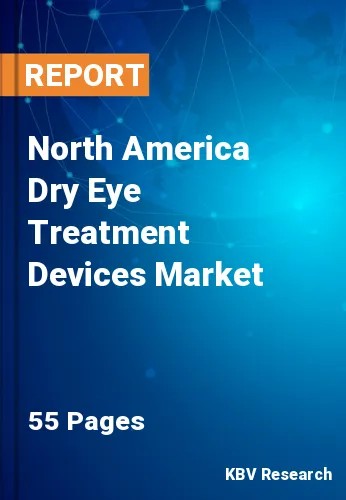The North America Dry Eye Treatment Devices Market would witness market growth of 6.7% CAGR during the forecast period (2022-2028).
Meniscometry, optical coherence tomography, tear osmolarity, the tear film normalization test, interferometry, tear film stability analysis, ocular surface thermography, and tear biomarkers are examples of emerging technology. Relevant autoimmune disease history, corrective eye surgery or drug use, allergies or rosacea, and oral medicine use are all patient-specific factors to consider. Clinical examination for lid margin disease, the appearance of lagophthalmos, or aberrant blink patterns is further patient consideration.
In its ophthalmic medication products, the US Food and Drug Administration (FDA) has designated OTC artificial tears. Specific types of demulcents or emollients utilized for human use are based on their chemical components rather than therapeutic efficacy. An emollient is a fat or oil substance that is applied locally to eyelids to protect or soften tissues to prevent drying and cracking, and a demulcent is a water-soluble polymer agent that is topically applied to the eye to safeguard and lubricate mucous membrane surfaces and relieve dryness and irritation.
Artificial tears are also necessary for treating the signs and symptoms of dry eyes and are sold commercially without a prescription. The main drivers driving the dry eye treatment devices market include the rising incidence of dry eye syndrome, rising use of preservative-free artificial tears, growing preference for sophisticated solutions for post-surgery treatment for dry eyes, and technical advancements. In addition, the new artificial tear medications are in various phase studies for the US FDA clearance procedure.
The most common kind of eye disease in the US is dry eye syndrome. This is explained by the enormous patient population in this region. Women from the southern United States had a high frequency of dry eye syndrome. The quality of life and performance of dry eye patients may be negatively impacted by these indoor and outdoor elements. Patients with mild dry eye illness may also have a conjunctival injection, irritability, itching, pain, burning, or sporadic vision blurring. When ocular surface desiccation or keratinization is severe, visual impairment may also be brought on by scarring, thinning, or ulceration of the cornea, which propels the adoption of the dry eye treatment device market.
The US market dominated the North America Dry Eye Treatment Devices Market by Country in 2021; thereby, achieving a market value of $93.2 million by 2028. The Canada market is experiencing a CAGR of 9.1% during (2022 - 2028). Additionally, The Mexico market would exhibit a CAGR of 8.1% during (2022 - 2028).
Based on Technology, the market is segmented into Meibomian Gland Expression (MGX), Broadband light (BBL), Intense Pulsed Light (IPL) and Combination (MGX+IPL). Based on End User, the market is segmented into Ophthalmic Clinics, Hospitals and Others. Based on countries, the market is segmented into U.S., Mexico, Canada, and Rest of North America.
Free Valuable Insights: The Global Dry Eye Treatment Devices Market is Estimated to reach $348.8 Million by 2028, at a CAGR of 7.4%
The market research report covers the analysis of key stake holders of the market. Key companies profiled in the report include MiBo Medical Group, Sight Sciences, Inc., Lumenis Ltd., ESW Vision SAS, Johnson & Johnson Vision Care, Inc. and Alcon, Inc.
By Technology
By End User
By Country
Our team of dedicated experts can provide you with attractive expansion opportunities for your business.

